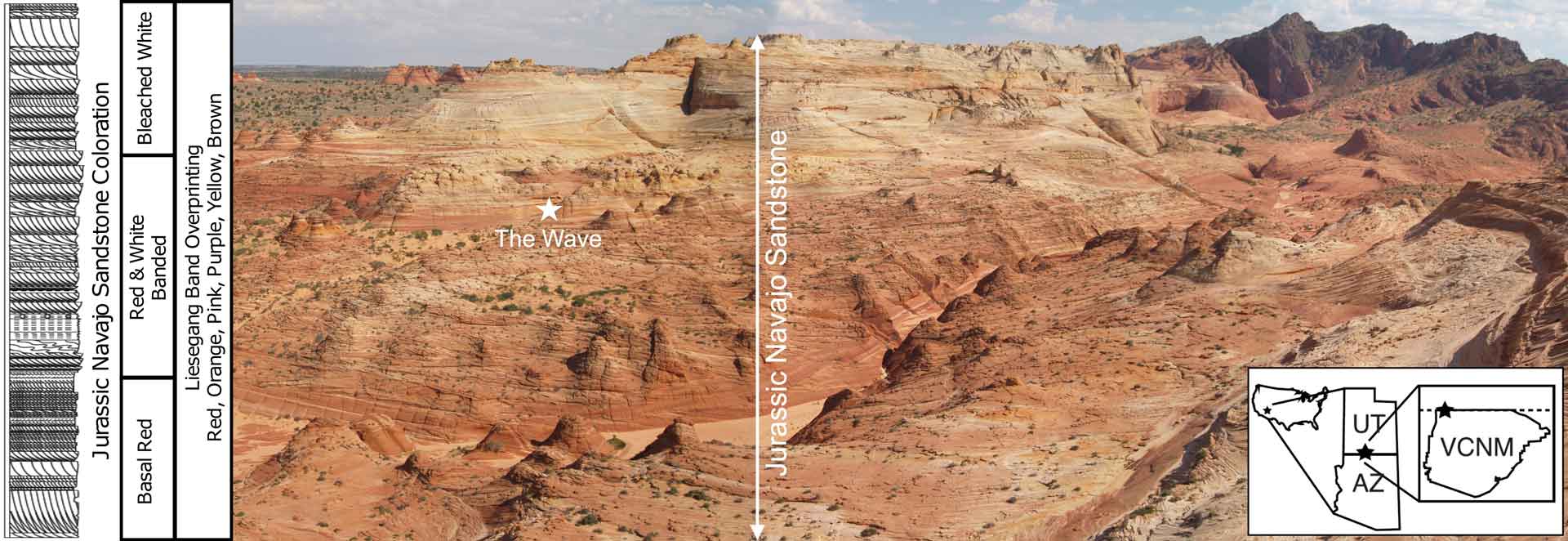The Jurassic Navajo Sandstone at Coyote Buttes and The Wave
United States of America

Wind funnels and circulates to form The Wave in aeolian Jurassic Navajo Sandstone. Cyclic cross bedding informs paleoclimate conditions, accentuated by diagenetic iron coloration. Image: M. Chan.
Geological Period
Lower Jurassic
Main geological interest
Stratigraphy and sedimentology
Geomorphology and active geological processes
Location
Vermilion Cliffs National Monument, Utah and Arizona, United States of America
36°59’45”N, 112°00’23”W
Wind funnels and circulates to form The Wave in aeolian Jurassic Navajo Sandstone. Cyclic cross bedding informs paleoclimate conditions, accentuated by diagenetic iron coloration. Image: M. Chan.
An iconic outcrop of aeolian stratigraphy, this colorfully sculpted Navajo Sandstone landscape records the largest erg in geologic history.
The Jurassic Navajo Sandstone preserves cyclic packages of thick aeolian cross bedding. These cross beds collectively record past wind directions and climatic conditions for the largest erg in geologic history, including preserved evidence of life and the dynamic processes of the vast, ancient desert (Loope and Rowe, 2003). Vibrant iron coloration reflects the diagenetic fluids that interacted within the porous sandstone. The Wave and Coyote Buttes capture the convergence of coloration and the exquisite etching and enhancement of cross bedding through modern erosion. This stunning combination is a world renowned destination for geologists, photographers, and outdoor enthusiasts.
- Geological description
The Lower Jurassic Navajo Sandstone preserves the largest erg in Earth’s history. Of all Navajo Sandstone outcrops, the Coyote Buttes is renowned for stunning coloration and outcrop features including The Wave — where vivid colors accent aeolian cross strata to resemble a cresting ocean wave.
Red, orange, pink, purple, yellow, brown and white colors document a complex history of chemical interactions between iron enriched fluids and ground water — concentrating or removing iron oxide grain coatings and cement within the sandstone. Coloration patterns are influenced by sedimentary textures and tectonic structures at microscopic to outcrop to regional scales (Seiler and Chan, 2014). The Wave’s sculpted form initiated with water incision along a prominent joint; winds actively scour and accentuate the aeolian bedding as the predominant contemporary erosional force (Loope et al., 2008).
The larger Coyote Buttes region likewise displays unique and spectacular alcoves, bowls, faces and bluffs shaped by wind and dramatically colored by fluid flow. Large dune sets show cyclic cross bedding driven by paleoclimate. Dinosaur tracks document a rich paleontologic history. Extensive soft sediment deformation suggests seismic shaking during the Jurassic (Chan and Bruhn, 2014). Contemporary weathering crack patterns compose analogs to Mars (Chan et al., 2008).
- Scientific research and tradition
The Coyote Buttes’ geologic history and corresponding research spans sand dune deposition, dinosaur trackways, burial, diagenetic coloration, and later exhumation with fine finishing touches of smooth, wind sculpted weathering. This geosite is unparalleled for exquisite preservation of aeolian laminae in dramatic colors.
- Reference
Chan, M.A. et al. (2008) ‘Polygonal cracks in bedrock on Earth and Mars: Implications for weathering’, Icarus, 194(1), pp. 65–71. Available at: https://doi.org/10.1016/j.icarus.2007.09.026.
Chan, M.A. and Bruhn, R.L. (2014) ‘Dynamic liquefaction of Jurassic sand dunes: processes, Origins, and implications’, Earth Surface Processes and Landforms, 39(11), pp. 1478–1491. Available at: https://doi.org/10.1002/esp.3539.
Loope, D.B. et al. (2008) ‘Wind Scour of Navajo Sandstone at the Wave (Central Colorado Plateau, U.S.A.)’, The Journal of Geology, 116(2), pp. 173–183. Available at: https://doi.org/10.1086/528902.
Loope, D.B. and Rowe, C.M. (2003) ‘Long-Lived Pluvial Episodes during Deposition of the Navajo Sandstone’, The Journal of Geology, 111(2), pp. 223–232. Available at: https://doi.org/10.1086/345843.
Seiler, W.M. and Chan, M.A. (2014) ‘Coloration and Diagenetic History of the Jurassic Navajo Sandstone at Coyote Buttes, Paria Canyon- Vermilion Cliffs Wilderness, Utah and Arizona’, in J.S. MacLean, R.F. Biek, and J.E. Huntoon (eds) Utah’s Far South: Utah Geological Association Publication, pp. 237–257.
- Author(s)
Winston Seiler.
University of Utah. USA.
Marjorie A. Chan.
University of Utah. USA.


